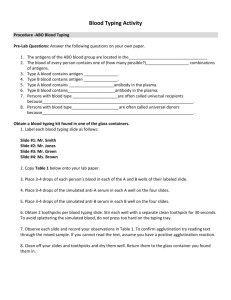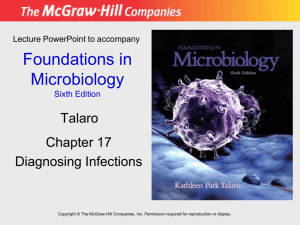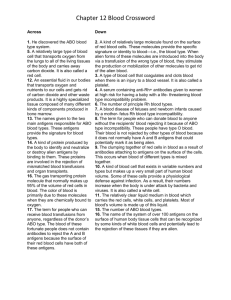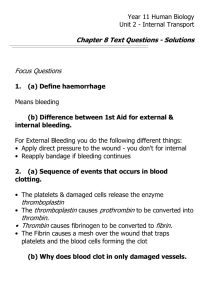Blood group B
advertisement
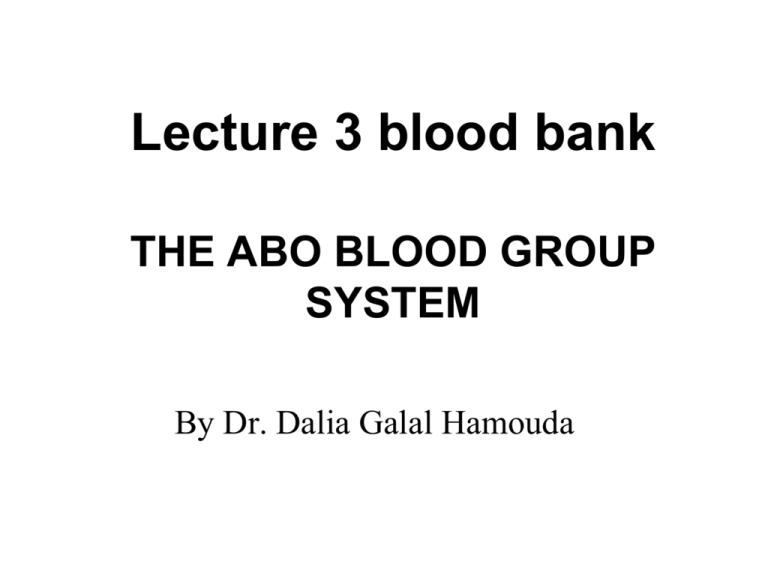
Lecture 3 blood bank THE ABO BLOOD GROUP SYSTEM By Dr. Dalia Galal Hamouda Importance of the ABO system Blood Group System is most important in blood transfusion ABO Antibodies • Natural antibodies found in the serum of people who lack the antigen and antigenic stimulus is environmental exposure occurs from birth • Newborns without ABO antibodies of their own; begin to produce Ab with detectable titer at 6 months of age • Other characteristics of ABO antibodies: 1. IgM 2. Reacts at room temp. after an immediate spin 3. If ABO antibodies react with antigens in vivo, result is acute hemolysis and possibly death Why do individuals produce antibodies to antigens they do not have? • The "A“ and "B" antigens are also produced by some other plants and microorganisms. Thus, individuals who do not recognize one or more of these antigens as "self" will produce antibodies against the plant or microbial antigens. ABO grouping is required for all of the following individuals: • Blood Donors-since it can be life threatening to give the wrong ABO group to the patient. • Transfusion recipients-since we need to know the donor blood is ABO compatible. • Transplant Candidates and Donors-ABO antigens are found in other tissues as well. Therefore the transplant candidates and donors must be compatible. • Prenatal Patients-To determine whether the mothers may have babies who are suffering from ABO-HDN. It is also beneficial to know the ABO group should she start hemorrhaging. • Newborns (sometimes) If the baby is demonstrating symptoms of Hemolytic Disease of the Newborn, the ABO group needs to be determined along with Rh and others. • Paternity testing Since the inheritance of the ABO Blood Group System is very specific, this determines that the accused father is the father or not ABO blood grouping system According to the ABO blood typing system there are four different kinds of blood types: A, B, AB or O (null). AB0 blood grouping system Blood group A If you belong to the blood group A, you have A antigens on the surface of your RBCs and B antibodies (anti-B) in your blood plasma. Blood group B If you belong to the blood group B, you have B antigens on the surface of your RBCs and A antibodies (anti-A) in your blood plasma. Blood group AB If you belong to the blood group AB, you have both A and B antigens on the surface of your RBCs and no A or B antibodies at all in your blood plasma. Blood group O If you belong to the blood group O (null), you have neither A or B antigens on the surface of your RBCs but you have both A and B antibodies in your blood plasma. ABO inheritance and genetics • The ABO gene is autosomal (the gene is not on either sex chromosomes) • The ABO gene locus is located on the chromosome 9. • A and B blood groups are dominant over the O blood group • A and B group genes are co-dominant • Each person has two copies of genes coding for their ABO blood group (one maternal and one paternal in origin) AUTOSOMAL CHROMOSOME A The alleles for Blood group are in the same place on the chromosome 9. However the genes have a different code giving the different blood group Sara one alleles from Mustafa and one from Sara. B Mustafa What do co-dominant genes mean? This meant that if a person inherited one A group gene and one B group gene their red cells would possess both the A and B blood group antigens. These alleles were termed A ( which produced the A antigen ), B (which produced the B antigen) and O (which was "non functional"and produced no A or B antigen) ABO BLOOD GROUP SYSTEM The table shows the four ABO phenotypes ("blood groups") present in the human population and the genotypes that give rise to them. Phenotype Antigen on RBCs (blood group) Natural antibody Genotype A A only Anti-B AA or AO B B only Anti-A BB or BO AB A and B None AB O None Anti-A, Anti-B OO ABO BLOOD GROUP SYSTEM Example of determining offspring blood types from known or suspected genotypes: Genotype parent #1 (AO) Genotype parent #2 (AB) A O A AA AO B AB BO Phenotypes of possible offsprings: A, AB, B Possible Blood group Genotypes Parent Allele A A B O AA AB AO B AB BB BO O AO BO OO Antiserum An antiserum is a purified, diluted and standardized solution containing known antibody, which is used to know the presence or absence of antigen on cells. Antiserum is named on the basis of the antibody it contains: - Anti- A antiserum which contains anti- A antibody - Anti- B antiserum which contains anti- B antibody - Anti- AB antiserum, which contain both anti A and B antibodies. - Anti –D antiserum which contains anti- D antibody Sources of antisera - Animal inoculation in which animals are inoculated by known antigen and the resulting serum containing known antibody is standardized for use as antiserum. - Serum is collected from an individual who has been synthesized to the antigen through transfusion, pregnancy or injection. Manifestation and Interpretation of Antigen- Antibody reactions The reactions (resulting from the combination of a red cell antigen with its corresponding antibody) are agglutination and/ or haemolysis. Hemolysis: is the break down or rupture of the red cell membrane by specific antibody (hemolysin) through the activation of complement with the release of hemoglobin and produce red color. Agglutination: is the clumping of red cells when antigens on the red cell membrane bind with their specific antibodies.it is the widely observed phenomenon in blood grouping. The agglutination of the red cells are called hemagglutination The antigen is called agglutinogen The antibody is called agglutinin. Hemagglutination of red cells takes place in two stages: First Stage: • red cell sensitization (when red cell become coated by antibodies) • Ag and Ab held by non-covalent interactions Second Stage: • The physical agglutination or clumping of the sensitized red cells (antibody attaches to antigen on more than one red cell) • formation of stable latticework basis of visible reaction

